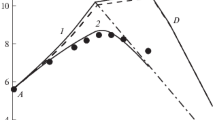Abstract
An explosive mixture of cyclotrimethylenetrinitramine (RDX) and titanium hydride (TiH2) is introduced. To investigate the explosion characteristics of the composite explosive, charges with various contents of the TiH2 powder are prepared and tested in air explosion experiments. Results show that the peak overpressure, positive duration, and positive specific impulse increase as the content of TiH2 increases from 10 to 20%, as compared to passivated RDX. The peak overpressure, duration, and specific impulse have the largest increase of 6, 9, and 23%, respectively, as compared to passivated RDX, when the TiH2 content is 20%. The effect of the TiH2 particle size is also considered. The charge containing the TiH2 powder with a mean particle size of 4.6 μm shows higher values of the three parameters than that containing 45-μm TiH2 particles under the condition of the same content of TiH2. However, the relationship between the detonation velocity and TiH2 content is a linear inverse proportion, and the particle size of TiH2 has a minor effect on it. Solid explosion products of the TiH2/RDX composite explosive are analyzed by x-ray photoelectron spectroscopy (XPS) and energy dispersive x-ray spectroscopy (EDX). TiO2 is found in explosion products, which is believed to form due to TiH2 oxidation.
Similar content being viewed by others
References
J. M. Gordon, K. C. Gross, and G. P. Perram, “Fireball and shock wave dynamics in the detonation of aluminized novel munitions,” Fiz. Goreniya Vzryva 49 (4), 76–90 (2013)
J. M. Gordon, K. C. Gross, and G. P. Perram, Combust., Expl., ShockWave 49 (4), 450–462 (2013).
Ya. F. Cheng, H. H. Ma, and Zh. W. Shen “Detonation Characteristics of Emulsion Explosives Sensitized by MgH2,” Fiz. Goreniya Vzryva 49 (5) 120–125 (2013)
Ya. F. Cheng, H. H. Ma, and Zh. W. Shen, Combust., Expl., Shock Waves 49 (5), 614–619 (2013).
H. Liu, P. He, J. C. Feng, et al., “Kinetic Study on Nonisothermal Dehydrogenation of TiH2 Powders,” Int. J. Hydrogen Energy 34 (7), 3018–3025 (2009).
S. C. Shark, T. R. Sippel, S. F. Son, et al., “Theoretical Performance Analysis of Metal Hydride Fuel Additives for Rocket Propellant Applications,” in 47th AIAA/ASME/SAE/ASEE Joint Propulsion Conf. and Exhibit, 2011.
C. F. Li, “Research of Raise Solid Propellant Burning Rate by using Titanium Hydride,” Winged Missiles J. 6, 34–37 (1997).
L. W. Collins, “The Stability and Compatibility of TiHx/KClO4 Pyrotechnics,” J. Hazard. Mater. 5 (4), 325–333 (1982).
L. W. Collins “Thermal Ignition of Titanium Based Pyrotechnics,” Combust. Flame 41, 325–330 (1981).
D. Sorensen, A. Quebral, E. Baroody, et al., “Investigation of the Thermal Degradation of the Aged Pyrotechnic Titanium Hydride/Potassium Perchlorate,” J. Therm. Anal. Calorimetry 85 (1), 151–156 (2006).
G. Bjarnholt, “Suggestions on Standards for Measurement and Data Evaluation in the Underwater Explosion Test,” Propel., Explos., Pyrotech. 5 (2-3), 67–74 (1980).
W. X. Liu, D. Z. Zhang, F. P. Zhang, and Y. Li, “Blast Loading Difference between Spherical Charge and Cylindrical Charge with Length Equal to Diameter at Small Scaled Distances,” Explos. ShockWaves 33 (3), 330–336 (2013).
M. M. Ismail and S. G. Murray, “Study of the Blast Wave Parameters from Small Scale Explosions,” Propel., Explos., Pyrotech. 18 (1), 11–17 (1993).
G. F. Kinney and K. J. Graham, Explosive Shocks in Air (Springer-Verlag, Berlin–New York, 1985).
J. F. Baytos, T. R. Gibbs, A. Popolato, LASL Explosive Property Data (Univ. of California Press, 1980).
E. G. Maksimov and O. A. Pankratov, “Hydrogen in Metals,” Usp. Fiz. Nauk 116 (7), 385–412 (1975).
C. Wagner and G. Muilenberg, Handbook of X-ray Photoelectron Spectroscopy (Perkin-Elmer, 1979).
G. Stepura, V. Rosenband, and A. Gany, “A Model for the Decomposition of Titanium Hydride and Magnesium Hydride,” J. Alloys Compounds 513, 159–164 (2012).
I. E. Gabis, A. P. Voit, E. A. Evard, et al., “Kinetics of Hydrogen Desorption from the Powders of Metal Hydrides,” J. Alloys Compounds 404, 312–316 (2005).
Y. F. Huang and X. F. Wang, “Reaction Mechanism of Metallized Explosive with Composite Metals Powder,” Chin. J. Explos. Propel. 27 (4), 26–28 (2004).
V. Bhosle, E. G. Baburaj, M. Miranova, et al., “Dehydrogenation of Nanocrystalline TiH2 and Consequent Consolidation to Form Dense Ti,” Metallurg. Mater. Trans. A 34 (12), 2793–2799 (2003).
K. G. Prashanth, “Influence of Mechanical Activation on Decomposition of Titanium Hydride,” Mater. Manufactur. Process. 25 (9), 974–977 (2010).
L. P. Orlenko. Physics of Explosion, (Fizmatlit, Moscow, 2002) [in Russian].
Y. F. Cheng, H. H. Ma, and Z. W. Shen, “Detonation Characteristics of Emulsion Explosives Sensitized by MgH2,” Chin. J. High Pressure Phys. 27 (1), 45–50 (2013).
W. Baker, Explosion in Air (Texas, 1973).
S. Samal, S. Cho, D. W. Park, et al., “Thermal Characterization of Titanium Hydride in Thermal Oxidation Process,” Thermochim. Acta 542, 46–51 (2012).
Author information
Authors and Affiliations
Corresponding author
Additional information
Original Russian Text © B. Xue, H.-H. Ma, Z.-W. Shen.
Published in Fizika Goreniya i Vzryva, Vol. 51, No. 4, pp. 101–108, July–August, 2015.
Rights and permissions
About this article
Cite this article
Xue, B., Ma, HH. & Shen, ZW. Air explosion characteristics of a novel TiH2/RDX composite explosive. Combust Explos Shock Waves 51, 488–494 (2015). https://doi.org/10.1134/S0010508215040140
Received:
Revised:
Published:
Issue Date:
DOI: https://doi.org/10.1134/S0010508215040140




